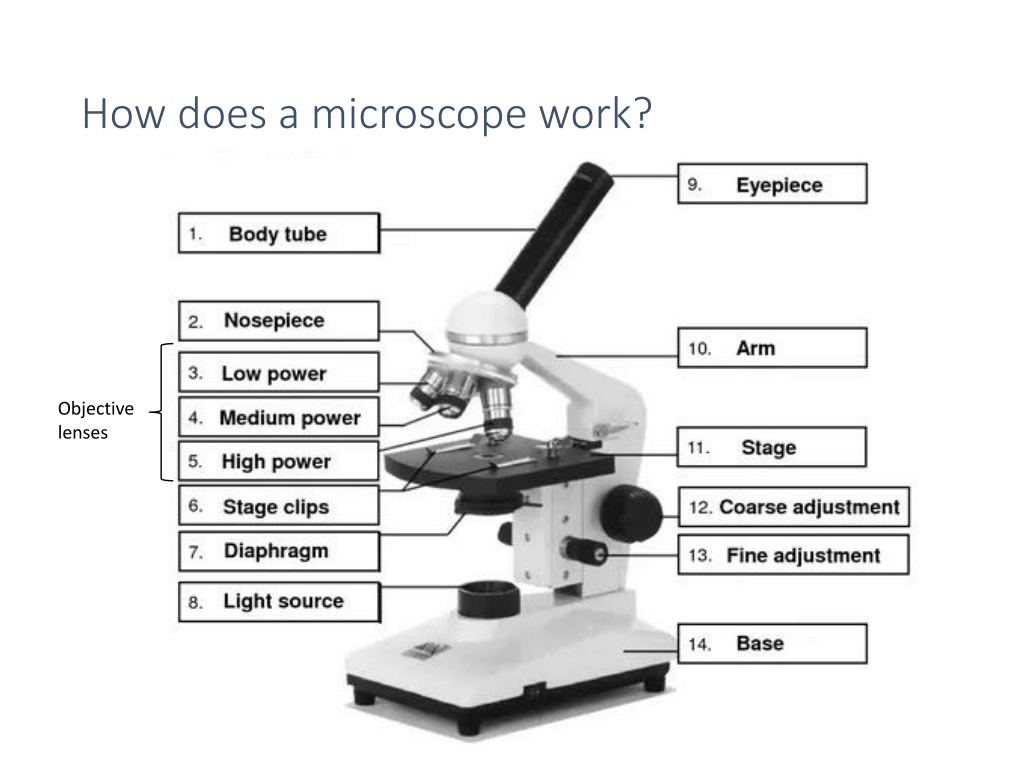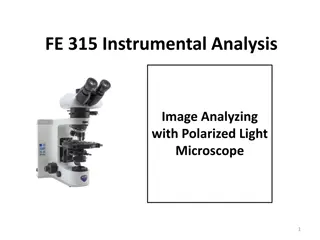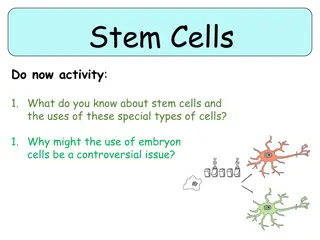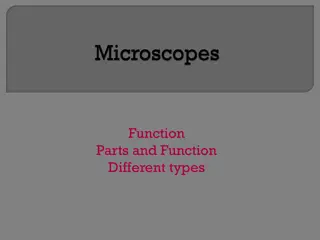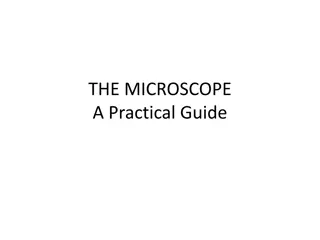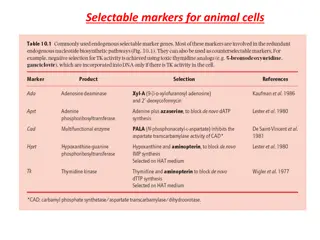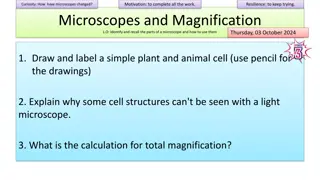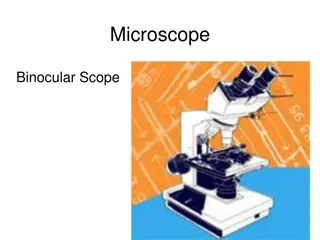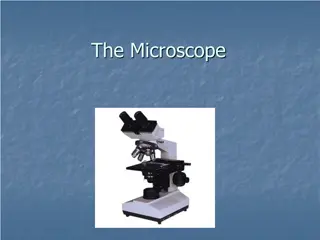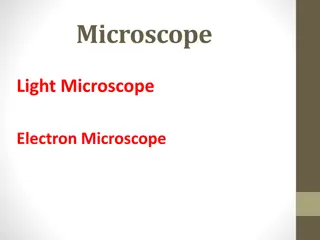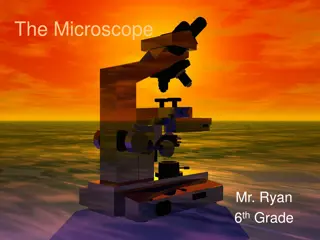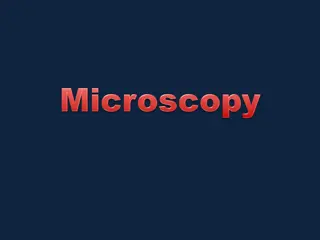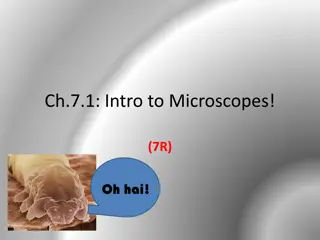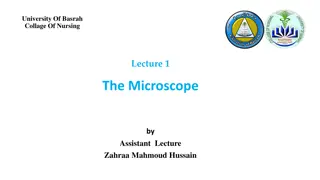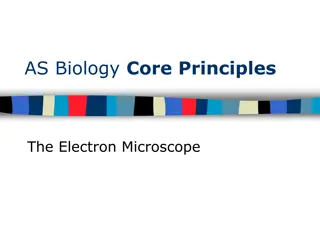Exploring the World of Microscopes and Cells
Delve into the fascinating world of microscopes and cells with details on how microscopes work, the functions of key microscope parts, the structure and function of cells, levels of organization in living organisms, and the concept of specialized cells. Discover the importance of objective lenses, focusing knobs, and common organelles in cell biology.
Download Presentation

Please find below an Image/Link to download the presentation.
The content on the website is provided AS IS for your information and personal use only. It may not be sold, licensed, or shared on other websites without obtaining consent from the author.If you encounter any issues during the download, it is possible that the publisher has removed the file from their server.
You are allowed to download the files provided on this website for personal or commercial use, subject to the condition that they are used lawfully. All files are the property of their respective owners.
The content on the website is provided AS IS for your information and personal use only. It may not be sold, licensed, or shared on other websites without obtaining consent from the author.
E N D
Presentation Transcript
How does a microscope work? Objective lenses
The function of some parts of the microscope:- Eyepiece: Eyepiece is the lens, present at the top and is used to see the objects under study (the specimen). Nosepiece: nosepiece has holders for the different objective lenses. It allows the rotation of the lenses while viewing. Objective lenses: Generally, three objective lenses are found on a microscope, the shortest lens is of the lowest power, and the longest lens is a high power lens. Diaphragm: Diaphragm helps in controlling the amount of light that is passing through the opening of the stage.
Focusing knobs: 1.Coarse adjustment knob: Used for focus on scanning. Usually the low power lens is used. 2. Fine adjustment knob: Used for focus on the high power lens.
Heres what a cell is! Cell - the smallest unit of an organism that carries on the functions of life. https://www.youtube.com/watch?v=_u3GEXZPDa8
Levels of organisation If similar cells work together they form a tissue. Tissues work together to perform a specialized function. They form an organ, like the heart. Various organs work together forming an organ system. Organ systems make up organisms.
All living things are made up of cells Some living things are made up of one cell or many cells. Unicellular Multicellular Consist of just one cell Consists of many cells Ex. Bacteria, protozoa and yeast Ex. Humans, animals, plants and insects
Specialized cells Most plants and animals are multicellular. The human body is made up of around 200 different types of cell, all working together. Most cells are specialized, meaning that each type of cell has a specific structure and function. All cells have certain common features and structures called organelles.
Three common organelles Three common organelles If we study a cell under a microscope, we would come across three features in almost every cell: Nucleus Cell membraneCytoplasm All activities inside the cell and interactions of the cell with its environment are possible due to these features.
A closer look at animal and plant cells Cheek cells are easily obtained and can be used to illustrate the main features of an animal cell. Onion cells are easily viewed under a microscope and can be used to illustrate the main features of a plant cell.
Cell wall Onion cell
Parts of animal and plant cell mitochondria
Animal or plant? Chloroplasts, nucleus, cell wall, cytoplasm, large vacuole, mitochondria, cell membrane Chloroplasts Nucleus Cell wall Cytoplasm Large vacuole Cell membrane Mitochondria
Cell Membrane Structure: the boundary of the cell Function (job): Maintains shape & size of the cell Controls entry and exit of substances in and out of the cell gatekeeper
Cytoplasm Structure: Jelly-like fluid formed by 80% water Function (job): Organelles float in cytoplasm All chemical reactions take place in the cytoplasm
Nucleus Structure: The location of cell s genetic material (DNA) Usually round/oval Function (job): Controls all the cell activities. Control center of cell
Mitochondria Structure: Mitochondria are membrane-bound cell organelles (mitochondrion, singular) Function (job): Perform cellular respiration. This means it takes in nutrients from the cell, breaks it down and turns it into energy. The powerhouse of the cell mitochondria
Chloroplast(ONLY IN PLANTS) Structure: Green, oval-shaped Contains green pigment called chlorophyll that absorbs the sunlight energy. Function (job): Site of photosynthesis Traps the sun s energy which is used to convert CO2 and water into glucose and O2.
Large vacuole(ONLY IN PLANTS)Structure: In animal cells vacuoles are small in size, Whereas in plant cells, vacuoles are large. Fluid-filled sac that floats in the cytoplasm The large vacuole in plants is filled with a liquid called cell sap. It contains dissolved sugar and salts. Function (job): Stores water, food materials and waste products Plant cells contain a large central vacuole - filled with water - helps give shape
Cell wall (ONLY IN PLANTS) Structure: Strong & rigid layer that surrounds the cell membrane. The plant cell wall is made from cellulose. Function (job): Protects the cell s contents. Maintains the shape and structure of the cell. Prevent damage to the cell caused by excess water intake.
How are plant and animal cells different? Animal cells Plant cells Cell wall absent Cell wall present Chloroplasts absent Chloroplasts present Vacuoles are small Large sap-filled vacuole
Match the organelle to the correct description Match the organelle to the correct description Which organelle is being described in each statement? Absorbs sunlight and turns it into useable energy
Match the organelle to the correct description Match the organelle to the correct description Which organelle is being described in each statement? Stores water; food and wastes for cell. Very large in plant cells.
Match the organelle to the correct description Match the organelle to the correct description Which organelle is being described in each statement? Controls all cell activities
Match the organelle to the correct description Match the organelle to the correct description Which organelle is being described in each statement? Semi-fluid substance inside cell where reactions take place; helps to support organelles
Match the organelle to the correct description Match the organelle to the correct description Which organelle is being described in each statement? Controls what enters and leaves the cell
Match the organelle to the correct description Match the organelle to the correct description Which organelle is being described in each statement? Made up of cellulose in plants; outer structural support for plant cells.
